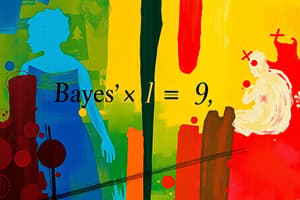Podcast
Questions and Answers
Which event is represented by the variable B?
Which event is represented by the variable B?
- The event of winning of James Hunt
- The event of raining
- The event of James losing a race
- The event of James winning a race (correct)
What is the probability of event A occurring?
What is the probability of event A occurring?
- 1/2 (correct)
- 1
- 2
- 1/4
What is the probability of event B occurring?
What is the probability of event B occurring?
- 1/2
- 1
- 2
- 1/4 (correct)
What is the conditional probability P(A|B)?
What is the conditional probability P(A|B)?
What does Bayes theorem rely on?
What does Bayes theorem rely on?
Which formula represents the probability of event A given event B has already occurred?
Which formula represents the probability of event A given event B has already occurred?
What is the probability of event A and event B happening together?
What is the probability of event A and event B happening together?
What does the blue shaded area represent in the diagram?
What does the blue shaded area represent in the diagram?
What does the red shaded area represent in the diagram?
What does the red shaded area represent in the diagram?
What is the formula for event B given event A has already occurred?
What is the formula for event B given event A has already occurred?
Flashcards are hidden until you start studying
Study Notes
Probability and Conditional Probability
- Variable B represents an event in probability theory.
- The probability of event A occurring is a measure of the likelihood of event A happening.
- The probability of event B occurring is a measure of the likelihood of event B happening.
- The conditional probability P(A|B) is the probability of event A occurring given that event B has already occurred.
Bayes Theorem
- Bayes theorem relies on conditional probability and is used to update the probability of an event based on new information.
- The formula for the probability of event A given event B has already occurred is P(A|B) = P(B|A) * P(A) / P(B).
- The probability of event A and event B happening together is represented by P(A ∩ B) = P(A|B) * P(B) = P(B|A) * P(A).
- In a Venn diagram, the blue shaded area typically represents the probability of event A occurring (P(A)).
- The red shaded area typically represents the probability of event B occurring (P(B)).
- The formula for event B given event A has already occurred is P(B|A) = P(A|B) * P(B) / P(A).
Studying That Suits You
Use AI to generate personalized quizzes and flashcards to suit your learning preferences.




